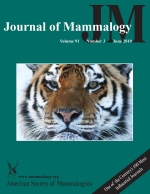I summarized data on eastern red bats (Lasiurus borealis), hoary bats (Lasiurus cinereus), and silver-haired bats (Lasionycteris noctivagans) that were obtained by mistnetting in the Lower Peninsula of Michigan over a 32-year span (1978–2009) to test published predictions, partly or wholly based on museum specimens, that adult sex ratios in summer are female-biased. Males were more common in the netting sample than females among silver-haired bats (88%; n = 57) and eastern red bats (70%; n = 458), whereas male and female hoary bats (n = 40) were equally abundant. Silver-haired bats and male hoary bats were more common north of a line separating the Deciduous Forest Biome and a transition to the Coniferous Forest Biome. The presence of male-dominated populations of all species at low-elevation sites in northern Lower Michigan suggested that distribution of the sexes in each species is more complex than previously thought. The sex ratio of adult eastern red bats was more skewed in July (74% male) than in June (58%), which might indicate late northward migration by males.
How to translate text using browser tools
16 June 2010
Reproductive timing, distribution, and sex ratios of tree bats in Lower Michigan
Allen Kurta
ACCESS THE FULL ARTICLE

Journal of Mammalogy
Vol. 91 • No. 3
June 2010
Vol. 91 • No. 3
June 2010
Bat
Chiroptera
Lasionycteris noctivagans
Lasiurus borealis
Lasiurus cinereus
Michigan
migration




